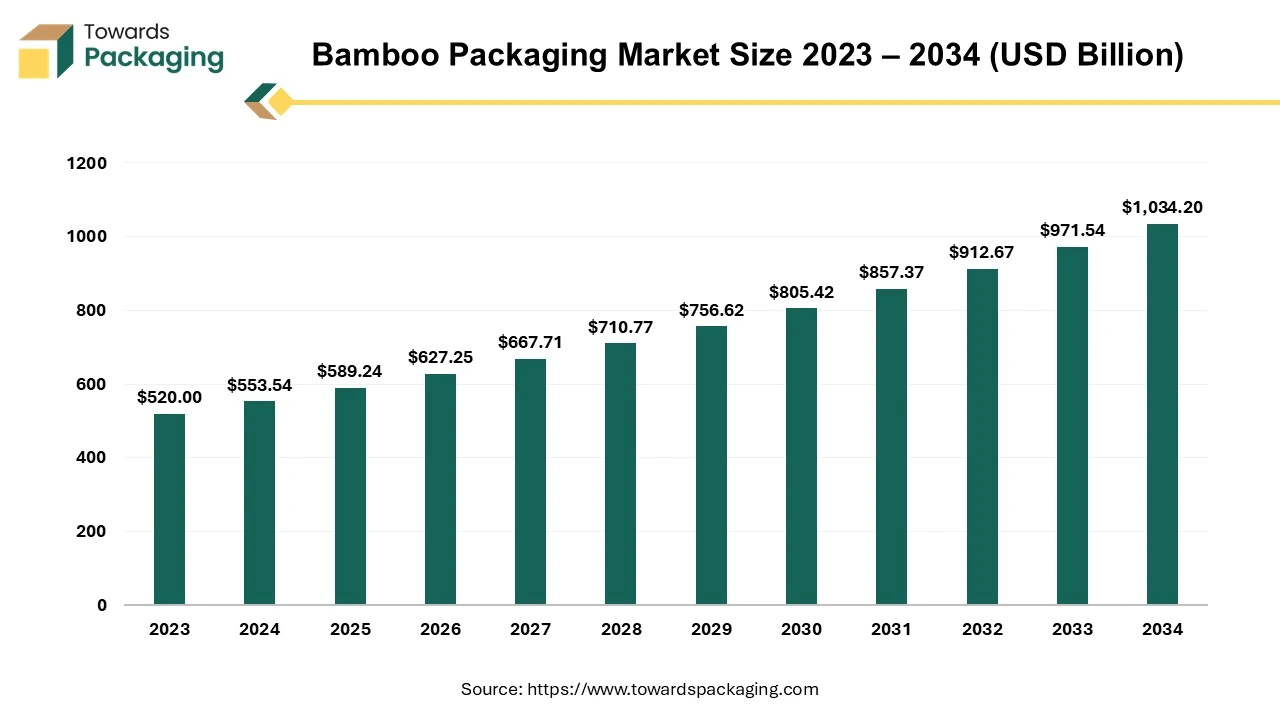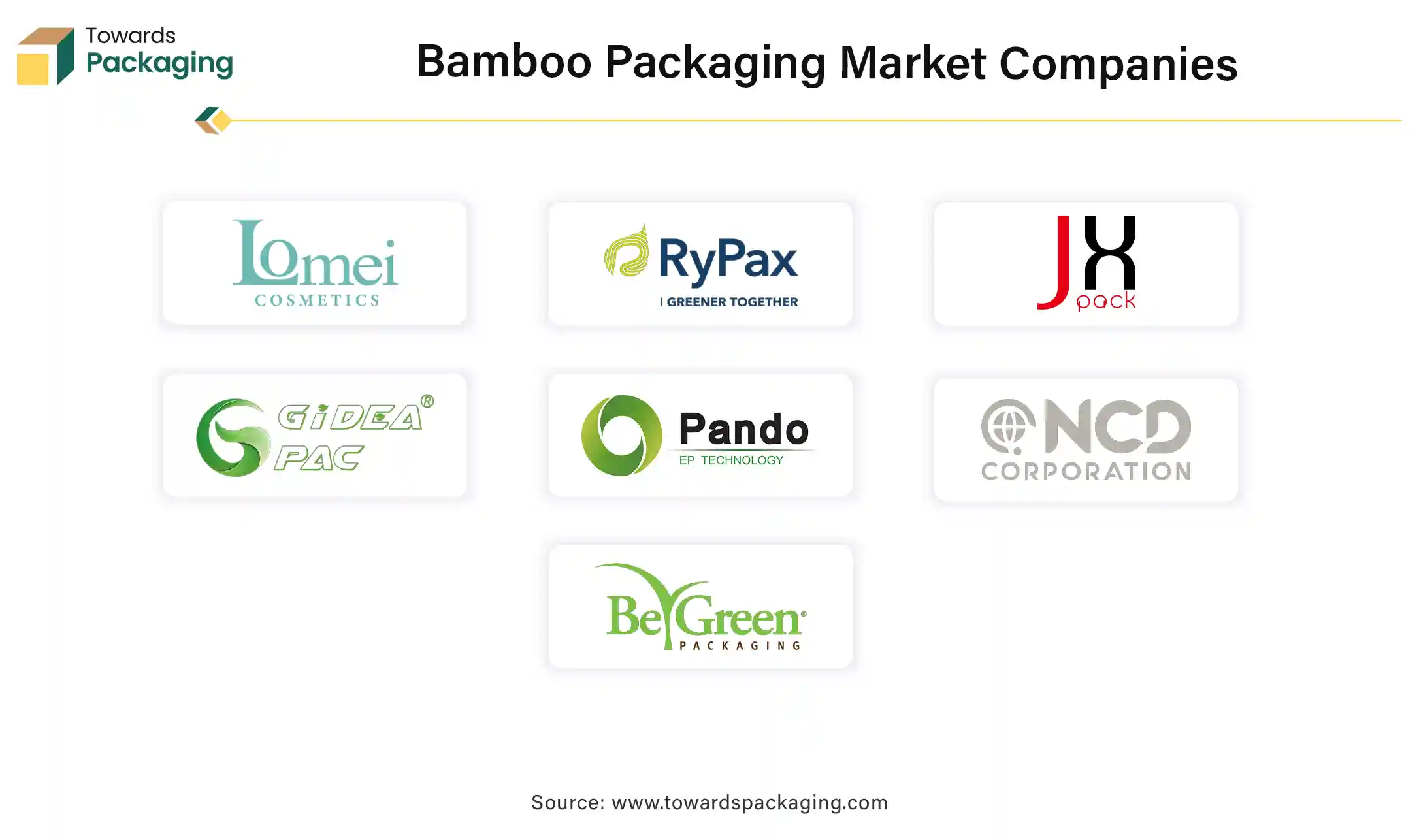November 2025
The global bamboo packaging market size to rise from US$ 589.24 million in 2025 to hit US$ 1034.20 million by 2034, expanding at a CAGR of 6.45% during the forecast period from 2024 to 2034. This market proliferates due to the rising concern towards environmental issues caused by the use of plastic for packaging purposes. Bamboo's properties as a natural source, decomposable, reused, and several others have influenced the bamboo packaging market.

The bamboo packaging market includes the section of the packaging sector that uses bamboo as the main raw resource for manufacturing several types of packaging for a wide range of products. This bamboo market is boosted by the rising demand for environment-friendly, sustainable, and recyclable packaging choices in response to the increasing ecological worries connected with regular plastic and non-recyclable packaging resources. The properties of bamboo comprise biodegradability, strength, and sturdiness, making it appropriate for a variety of packaging purposes, from electronics to food & beverage containers, cosmetics, and various others, boosting the market development.
Growing ecological consciousness is a key driver for market development. As apprehensions related to plastic waste and ecological deprivation base, market players and customers are dynamically looking for sustainable substitutes. Bamboo is commonly identified for its fast development and fewer ecological effects offer a feasible result. Its usage in packaging decreases dependence on plastics and favours eco-friendly products, influencing the demand in several industries comprising food & beverage, cosmetics, and customer goods.
| Metric | Details |
| Market Size in 2024 | USD 553.54 Million |
| Projected Market Size in 2034 | USD 1034.20 Million |
| CAGR (2025 - 2034) | 6.45% |
| Leading Region | Asia Pacific |
| Market Segmentation | By Pulp Type, By Packaging Type, By End-Use and By Region Covered |
| Top Key Players | Lomei Cosmetics Ent. Co., Ltd., Bloom Eco Packaging, RyPax, Guangzhou Jiaxing Glass Products Co., Ltd., Gidea PAC. |
In the bamboo packaging market, there is a huge impact of AI as it supports manufacturing cost-effectively, conveniently, and innovative patterns of packaging for a variety of products. AI incorporation helps market players to gather real-time data related to the demand of the customers and develop products according to their choice which increases the demand for such packaging. It eliminates the defective pieces automatically which helps in supplying enhanced-quality packaging.
With the help of machine learning and automation, it becomes easy for market players to produce packaging which is considered suitable by the consumers. It reduces the labour cost required for the production of bamboo packaging which ultimately reduces the overall charges of the packaging. There are several benefits associated with the integration of AI in the bamboo packaging industry.
The bamboo packaging market is driven by several factors one of the major reasons is the growing demand for sustainable packaging solutions. With the rising awareness about environmental issues caused by the usage of plastic packaging, there is a rapid shift toward eco-friendly packaging options. These packaging are also used majorly as these are safe for products to store for a longer period. There are several market players significantly working towards developing innovative packaging products which can help to store products safely away from any environmental issues like air, light, and moisture.
Bamboo is considered to be a rapidly growing renewable material and has appeared as a widespread solution because of its nominal ecological influence and biodegradability. Bamboo packaging is fast adhesion for its sustainability assistances. Bamboo plants grow quickly, need less water, and do not require any fertilizers or pesticides, due to this it is considered an ecologically friendly replacement for plastic. Moreover, bamboo packaging is decomposable, whereas plastic can take several years to decay.
The growing demand for innovative packaging and processing technologies to develop a variety of patterns. Advancements in production technology have drastically improved the performance and versatility of the packaging products. The ability to manufacture packaging with several textures, finishes, shapes and sizes has enhanced the market potential of bamboo packaging. The capacity to transform widely to produce different patterns for packaging according to the requirements of several sectors such as cosmetics, food & beverages, and various others has significantly influenced the market to enlarge the scope. There is an upsurge in producing packaging to reduce wastage and affordable to a wide range of customers.
Technological revolutions have empowered bamboo to be managed into several forms of packaging starting from strong cartons and containers to elastic packages and decomposable films. These progressions permit bamboo to strive with old-style resources such as metal, plastic, and cardboard while contributing more sustainable replacements. New processing methods, such as better-quality pulping, moulding, and paper-creation machinery, improve the superiority and sturdiness of the packaging which results in the manufacturing of appropriate products for a wide variety of purposes, comprise food, personal care, and electrical packaging.
Additionally, the incorporation of smart packaging resolutions in bamboo packaging is escalating the potential of the market. Features such as RFID technology, QR codes, and tamper-evident seals are majorly added in the bamboo packaging which add value and enhance customer attraction.
The cost of bamboo packaging in comparison to traditional packaging is high due to several reasons such as resource availability, production costs, machinery charges, and various others which hinder the growth of the bamboo packaging market. It also has a higher supply cost than other materials which becomes a challenge for this market development.
The recycled pulp segment dominated the market in 2024. These are highly in demand as these pulps are considered a substitute for virgin pulp. These are collected from the waste of post-consumers and used as an eco-friendly option. These are widely used due to the continuous search for sustainable packaging options available for generating the packaging of the products. These are also cost-effective solutions available in the bamboo packaging market.
As these are derived from post-consumers the need for fresh bamboo as a raw material decreases which as a result lower energy consumption and deforestation-type issues. Additionally, recycled pulp holds various benefits of bamboo, including decomposability and sturdiness. These pulps can be managed into a huge variety of packaging procedures starting from paper wrappers to moulded things which make it useful for numerous applications, like cosmetic wrapping, retail goods, and food flasks.
The cups & straws segment held the largest share of the market in 2024. This is due to the growing demand for sustainable and eco-friendly packaging demand among consumers. With the growing concern for the environment among customers, there is a huge reduction in the demand for single-use plastic packaging. Bamboo cups and straws are highly used by the food & beverages sector as these are safe to use and affordable with appealing designs. Such packaging also enhances the brand value and helps to attract more customers with initiative for environmental issues.
These cups and straws are extensively used in several places such as café, restaurants, and various other places which increases their market demand and results in high production. In several places, the usage of plastic is banned which compels the use of such alternatives and contributes to market development. Due to the advancement in technology, there is a variety of patterns of bamboo cups and straws available in the market.
The food & beverages segment held the largest share of the market in 2024. Food & beverage bamboo packaging is leading the packaging end-use segment of this market. Bamboo packaging is profoundly used for manufacturing trays, containers, and spoons. There is a huge impact of such products which helps to draw customers' attention towards brands or food outlets that use these organic products. These can be moulded into any shape and size which makes these more preferrable. Moreover, the move in the direction of eco-aware dining raises the demand for eco-friendly products.
Asia Pacific is estimated to generate the highest revenue over the forecast period. This is due to the presence of abundant resources and the availability of raw bamboo. The growing awareness towards the usage of organic products and their decomposability capacity boosts market development. Countries such as India, China, Japan, South Korea, and Thailand are contributing significantly towards the growth of the market due to the high cultivation of raw bamboo plants which help to gather huge raw materials for manufacturing different products. Due to the rising number of market players which produce more effective products which can be utilized for several sectors for packaging of products. The rising shift in the middle class towards bamboo products contributes significantly to the development of the bamboo packaging market.
China Market Trends
China bamboo packaging market is driven by the abundant bamboo resources and rising environmental awareness. China is integrating circular economy concepts into its packaging industry, focusing on recyclability and waste reduction. Bamboo packaging’s compostable nature supports these goals, contributing to a more sustainable packaging ecosystem. China’s well-established manufacturing sector facilitates large-scale production of bamboo packaging. The country’s capabilities in mass production and export of eco-friendly packaging solutions position it as a leader in meeting global demand. China possesses vast bamboo forests, covering over 7.56 million hectares and encompassing more than 800 species. This extensive availability ensures a steady and cost-effective supply of raw materials for bamboo packaging manufacturers, reducing reliance on imports and enhancing supply chain efficiency.
North America witnessed the fastest-growing revenue share for the year 2024. This is majorly due to the significant growth in the food service sector. There are several food outlets available in countries such as the U.S. and Canada and also working people which collectively increase the demand for eco-friendly packaging of food products. Continuous growing food services simultaneously increase the demand of the bamboo packaging market.
U.S. Market Trends
U.S. bamboo packaging market is driven by supportive regulatory environment and technological advancements. The U.S. benefits from well-developed infrastructure for sourcing and processing bamboo. Technological innovations have improved the quality and scalability of bamboo packaging, making it a viable alternative to traditional materials. This robust infrastructure supports the efficient production and distribution of bamboo packaging products. American consumers are increasingly prioritizing eco-friendly and biodegradable packaging options. This shift in consumer preferences is propelling the demand for bamboo-based packaging solutions across various industries, including food and beverages, cosmetics, and personal care.

By Pulp Type
By Packaging Type
By End-Use
By Region Covered
November 2025
October 2025
October 2025
October 2025